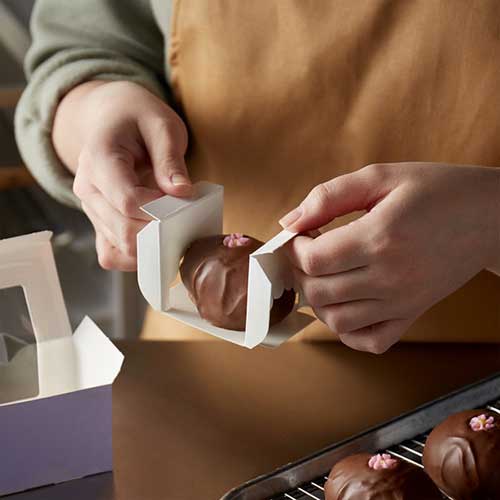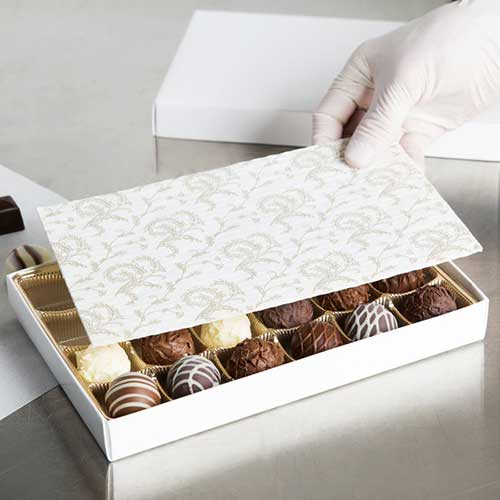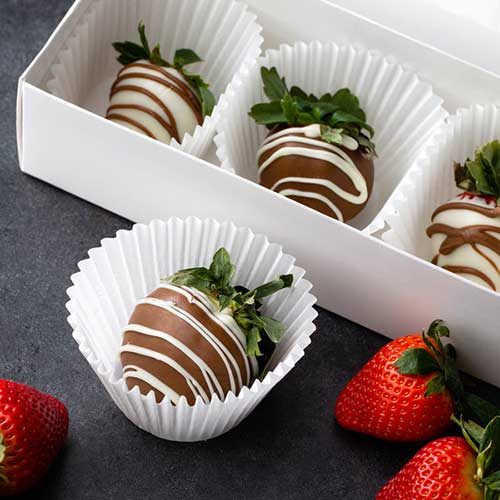How to Ship Chocolate
In this interconnected environment, shipping chocolate straight to your customers anywhere in the country is vital to your success. However, chocolate's temperature sensitivity presents many challenges, especially when mailing it across long distances. Whether you have a booming e-commerce business or you're mailing food for the first time, use our chocolate shipping guide to deliver your products to customers.
Shop All Mailing, Shipping, & Packing SuppliesHow to Pack Chocolate for Shipping

You put time, love, and labor into creating delicious chocolate candies, so you should sell and share them outside your immediate area. Learn how to pack chocolate for shipping so it holds its form and flavor.
- Work with cold, clean hands. Chocolate has a softening point lower than the human body temperature, so run your hands under cold water before packaging your chocolate.
- Keep your chocolates in a wine cooler before shipping them. Shipping chocolate requires careful temperature planning because cold induces sugar bloom while warmth melts the chocolate. Many chocolatiers store their chocolates in wine refrigerators to cool them down without causing sugar bloom before shipping them.
- Add your chocolates to a chocolate box. Remember to take the same care and consideration for presentation as packing your chocolates at your storefront. A positive unboxing experience goes a long way toward generating brand loyalty.
- Build your shipping box. Use an insulated shipping box that is double or triple the size of your chocolate container. The additional space separates your chocolate from the heat and protects your truffles from getting smashed if the box dents in transit.
- Line the bottom of your shipping box with metalized bubble packaging. Metalized packing bubbles deflect the heat, insulate the chocolates, and provide cushioning.
- Decide whether you need cold packs. Based on the time of year, destination, and distance your chocolates are traveling, determine how many cold packs you need to prevent your chocolates from melting.
- If using cold packs, place one on the bottom of the shipping container. Wrap the cold packs in a resealable plastic food bag or another leak-proof container. This precaution prevents condensation from hurting your chocolates or leaking into the shipping box.
- Insert the chocolate box into the shipping container. If applicable, surround it with cold packs. Fill remaining gaps with packing materials.
- Add a sheet of metalized insulation to the top of the package. It should cover the entire top of the package.
- Secure the shipping box. Tape all the seams to reduce warm air penetration.
- Add the shipping labels. Your chocolates are ready for shipment!
Chocolate Packaging Supplies
Use the following chocolate packaging supplies to pack your chocolate for shipping.
- Insulated boxes for shipping
- Cold packs for shipping chocolate
- Metalized bubble wrap
- Chocolate box
- Shipping paper
- Tape
- Mailing and shipping labels
How to Ship Chocolate without Melting
The most challenging part of shipping chocolate is preventing it from melting. Chocolate softens at 72 degrees Fahrenheit, which puts it at risk of smudging, taking on fingerprints, and receiving structural damage. While chocolate's heat sensitivity makes shipping precarious, chocolatiers can thrive in the e-commerce market by following chocolate shipping best practices.
- Elect to delay shipment orders. Some chocolatiers elect to delay shipments if the temperature spikes. As long as you communicate, customers are less frustrated by prolonged arrival than by ruined products.
- Use overnight shipping. If you plan to ship chocolates in the summer, use overnight shipping to ensure they arrive intact.
- Choose insulating and cooling packing materials. Metalized bubble packaging insulates your chocolates and deflects the heat. Nestling your chocolate box in ice packs keeps them below their softening point.
- Don’t ship chocolate orders Thursday through Sunday. Shipments leading up to and on Saturday and Sunday remain in hot warehouses over the weekend. To avoid this, let your customers know you won't ship orders placed on these days until Monday. Send them an email confirmation once their order ships so they have confidence and clarity about your process.
- Provide an arrival alert. After working hard to ensure your chocolates remain intact during transit, the last thing you want is for them to melt on your client’s doorstep. Provide updates on the shipping progress so your customer can bring them inside as soon as they arrive.
Can You Freeze Chocolates?
While freezing is an excellent preservation strategy when shipping baked goods, avoid it at all costs when shipping chocolate. Cooling chocolate, then exposing it to warm air, causes condensation to form on its surface. The moisture dissolves some of the chocolate's sugar content. When the sugar recrystallizes, it creates a white, grainy layer known as “sugar bloom" that distorts the taste and texture of your chocolate.
While traditional freezing and refrigeration are ill-advised, some chocolatiers store their chocolates in a wine cooler to prevent them from softening. Operating between 45 and 67 degrees Fahrenheit, wine coolers are not as cold as refrigerators. Setting a wine cooler to its warmest operating temperature keeps ganache-filled truffles intact without inducing a sugar bloom.
Keeping your chocolates cool before shipping helps prevent them from melting in the mail. If you store your chocolates in a wine cooler, place distinct flavors in airtight containers to preserve their taste. Cocoa butter absorbs odors and flavors, so keeping blueberry truffles and chocolate turtles side by side will cause flavor perversion.
Do All Chocolate Candies Have the Same Melting Point?
While the average melting point for chocolate across all types is between 86 and 90 degrees Fahrenheit, not all chocolate candies have the same melting point. Chocolate candy uses two extracted portions of the cocoa bean: cocoa solids and cocoa butter. Most white and dark chocolate contain comparable amounts of cocoa butter, but chocolatiers increase the candies' darkness by adding more cocoa solids. Since white chocolate has no cocoa solids to absorb liquefying cocoa butter, it melts fast. Milk chocolate and ruby chocolate contain some cocoa solids, but not as much as dark chocolate.
Should You Ship Chocolates in the Summer?
Some chocolatiers forgo shipping chocolate in the summer months. You might lose some business by foregoing summer shipments, and the proper packaging makes this profit reduction avoidable. However, shipping chocolate in the summer may not be cost-effective based on the size of your operation and the location of your primary clientele. Ask yourself these three questions to determine whether your chocolate shop is up to filling summer shipment orders:
- Where are you shipping to? If most of your clients are from warm-weather areas, mailing chocolates in the dead of summer will be expensive.
- Is it cost-effective? The additional fees may scare off customers, making it nonsensical to stock chocolate shipping supplies over the summer for the number of orders received.
- How big is your operation? Shipping chocolates during the hottest months of the year requires a vigilant eye on weather patterns, careful packaging, and detailed shipping timelines. If you are the sole employee of your chocolate business or operate with a limited staff, you may not have the help you need to tackle summer chocolate shipments.
If you can't choose between the risk of losing business or losing products, you could exclusively ship to cool weather states from June through August. Alternatively, you could include a pop-up link to other candies you ship during the summer if a potential customer tries to add chocolate to their online cart during the hottest months.
Back to TopBest Way to Ship Chocolate

Now that you know how to package your sweets, you must determine the best way to ship your chocolate. Many chocolatiers offer standard and expedited shipping based on the season and candy purchased. If your client lives in a destination warmer than 70 degrees Fahrenheit, consider requiring them to ship Next Day Air via UPS. In cooler climates, USPS two-day mail is a reliable and economical alternative. Additionally, follow our top tips for the best way to ship chocolate.
- Know your chocolate box dimensions and average weight. Before choosing a shipping carrier, you need to know your packages’ average dimensions and weight to pick the most affordable carrier for your products.
- Provide total transparency. If your customer’s shipment requires ice packs and other special packing materials, charge for them. Patrons appreciate transparency, so give a breakdown of shipment costs at checkout and include the price of the ice packs.
- Consider including shipping in the sales price. Offering free shipping discloses the total expense of ordering your chocolates from the start. This method helps prevent abandoned carts once the customers see the shipping fees.
- Offer custom tracking. Post-purchase platforms allow you to create a customized tracking page. You can provide food storage instructions and beverage pairing ideas on your custom page.
How to Ship Chocolate Covered Strawberries

Shipping temperature-sensitive and perishable chocolate-covered strawberries requires extreme care. Follow these steps to ship your chocolate-covered strawberries and prevent spoiling.
- Chill the strawberries. Refrigerate the strawberries for two hours or until hard to prevent the chocolate from melting in transit.
- Once cold, package and ship. Chocolate-covered strawberries refrigerated for more than a day will not arrive at their shipping destination fresh.
- Wrap each chocolate-covered strawberry. Cellophane wrap will mold itself to the strawberry. Once wrapped in cellophane, place the strawberries in large baking cups.
- Place the strawberries in a sturdy container with a tight sealing lid. The container needs to be durable enough to protect the strawberries. Leave an inch of buffer space between the strawberries to prevent them from bumping into each other.
- Add your box of strawberries to an insulated box. This larger box will ward off heat, preserve your strawberries’ freshness, and keep the chocolate from melting.
- Lay packing peanuts or packing bubbles on the bottom of your shipping box. This creates a cushioning layer for your strawberries.
- Fill the empty spaces in your shipping container with packing materials. Once you secure the strawberry box on all sides, layer packing materials on top and seal the shipping container with packing tape.
- Choose the fastest delivery service. Keep the chocolate-covered strawberries from spoiling by selecting overnight, express, or one-day delivery.
How to Ship Chocolate Covered Pretzels

Because pretzels are prone to breakage and chocolate is prone to melting, you must take exceptional care when shipping chocolate-covered pretzels. We break down how to ship chocolate-covered pretzels below.
- Package the pretzels. If you use pretzel rods, individually heat-seal each pretzel before adding them to a sealable food-grade bag. For regular pretzels, heat-seal your servings together. Bags absorb the impact if the carrier drops the shipping container. If you place the pretzels in a rigid container, they are more likely to shatter from crashing against the hard material.
- Label and seal the food-grade bag. Add branding to your chocolate-covered pretzels and create an attractive unboxing experience. Be sure to include FDA-required allergy and calorie information.
- Add the bag to a bubble mailer. Bubble mailers help protect your chocolate-covered pretzels during transit.
- Assemble a mailing box. You can pick up large mailing boxes for free at the post office. Tape all the seams to prevent cold air from escaping when you add the ice packs.
- Fill in the shipping box. Lay a cushioning bubble packaging layer on the bottom of the shipping box. Then, add your bubbled mailer and surround it with packing bubbles.
- Insert ice packs. For smaller orders, use one 6 oz. ice pack and nestle it to the side of your bubbled mailer. For larger orders, add two 6 oz. ice packs, one to the side of the bubbled mailers and one in between them.
- Seal the shipping box. Add another cushioning layer atop the contents before sealing your shipping box. Seal all the edges to contain the cold.
How to Ship a Breakable Chocolate Heart
Breakable chocolate hearts are hollow chocolate hearts filled with candy and sprinkles. They come equipped with mini mallets and make a cute, interactive dessert experience for Valentine’s Day or any time of the year. Given their fragile nature, you must take extra care to ensure your clients don’t receive a shattered heart lest it be an omen for their future. Learn how to ship a breakable chocolate heart below.
- Pack your breakable chocolate heart in a heart-themed chocolate box. This opportunity allows your branding to shine.
- Wrap the chocolate box in packing bubbles. The bubble packaging provides the first layer of protection.
- Assemble your shipping container. Tape all seals so balmy air doesn’t leak into your box.
- Lay air pillows on the bottom of your shipping container. This buffers against rough handling.
- Add the chocolate box to the shipping container. Include any notes, details, or promotional flyers at this stage.
- Drape packing bubbles over the chocolate box before adding the ice packs. The bubble packaging protects your chocolates from condensation.
- Add three ice packs. Place one on top of the chocolate box and the remaining two on its sides.
- Leave no space. Fill all remaining areas with packing materials.
- Tape the shipping box closed. Seal all the seams to preserve a cool internal temperature.
How to Create an Unboxing Experience

A chocolatier’s priority is to have their shipments arrive intact, but a memorable unboxing experience goes a long way to boost brand loyalty. It provides free advertising when customers post their unboxing experience on social media. Here are some tips for creating a chocolate unboxing experience your customers will want to share.
- Ship your chocolate in branded boxes. Knowing the box is from your chocolate shop as soon as it arrives builds anticipation.
- Use attractive and sustainable packing materials. Customize your internal materials to create a cohesive aesthetic. If you use sustainable packaging, include an insert that shares this information with your customers. Environmental responsibility can earn respect and boost brand loyalty.
- Think like a merchandiser. Consider the color scheme of the cushioning materials and how they complement your items. Use dividers to manage your products' placement, and browse the social media hashtags #unboxing and #flatlay for inspiration.
- Provide free samples. Free samples introduce your clients to other product lines and encourage repeat business. For example, if your customer ordered a shipment of your chocolate truffles, consider adding a sample of your caramels or toffee.
- Personalize the package. From handwritten notes to customizable gift packaging, personal touches encourage repeat business.
- Add inserts. Insert coupons, new flavor/product promotions, or branded stickers.
- Mark the package as perishable. This label is for the customer, not the carrier. If someone sends your chocolates as a gift, you want the recipient to know they should open the box upon arrival.
With the rise of ghost kitchens, storefronts are no longer necessary to sell gourmet chocolate desserts. However, you need a solid shipping strategy to ensure your goodies arrive intact. Whether your chocolate shop is ramping up its shipping strategy or you want to create a virtual chocolate brand, use this resource to deliver your chocolates without compromising them.



